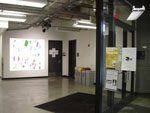As a interaction designer looking to engage the public and mediate a design experience, I have identified that the simplest manner of interactivity occurs within daily routine. By identifying routine movements and translating these into a design experience, the public can see the results of their daily actions. This concept of engaging the public on a routine level is drawn in part from the inspiring work of Electroland (Damon Seely and Cameron McNall). McNall explains the integration of Electroland's work as, "There's no sign there that says . . . 'Do this or do that.' We're just trying to create these gentle overlays of experiences and give them some depth." This integration principle is exhibited within their pieces such as the Target Breezeway and EnterActive, both of which exist as fully functioning designs without the need for interaction beyond that which already exists.
Within the context of my piece, it is relevant to use pre-existing movements as the basis for the result, in order for the piece to subtly co-exist within the everyday environment. emergent identity builds off inadvertent interactions by engaging the U of M art students as they walk through the entryway of their building, an action they perform numerous times within their daily routine.
The designs of Diller Scofidio + Renfro (i.e., The Brasserie and Facsimile) reveal the inner workings of a place and present it to the public, including those not currently engaged within the space. Likewise, emergent identity is also available for all to view and understand the sense of contribution and growth that occurs within the U of M West Bank arts community, allowing for an immediate reaction from its contributors as well as those not directly involved.


